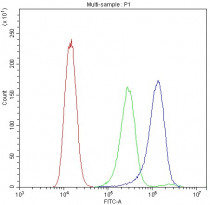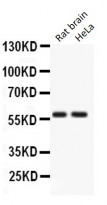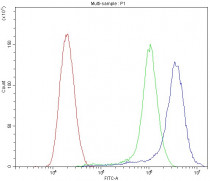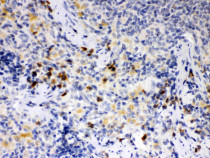ARG59071
anti-ATG14 / ATG14L antibody
anti-ATG14 / ATG14L antibody for Flow cytometry,ICC/IF,IHC-Formalin-fixed paraffin-embedded sections,Western blot and Human,Rat
Overview
| Product Description | Rabbit Polyclonal antibody recognizes ATG14 / ATG14L |
|---|---|
| Tested Reactivity | Hu, Rat |
| Predict Reactivity | Hm |
| Tested Application | FACS, ICC/IF, IHC-P, WB |
| Host | Rabbit |
| Clonality | Polyclonal |
| Isotype | IgG |
| Target Name | ATG14 / ATG14L |
| Antigen Species | Human |
| Immunogen | Synthetic peptide corresponding to aa. 70-101 of Human ATG14 / ATG14L (RDRERFIDKKERLSRLKSKQEEFQKEVLKAME). |
| Conjugation | Un-conjugated |
| Alternate Names | BARKOR; Autophagy-related protein 14-like protein; Beclin 1-associated autophagy-related key regulator; Barkor; KIAA0831; Atg14L; ATG14L |
Application Instructions
| Application Suggestion |
|
||||||||||
|---|---|---|---|---|---|---|---|---|---|---|---|
| Application Note | IHC-P: Antigen Retrieval: Heat mediated was performed in Citrate buffer (pH 6.0) for 20 min. * The dilutions indicate recommended starting dilutions and the optimal dilutions or concentrations should be determined by the scientist. |
||||||||||
| Observed Size | ~ 57 kDa |
Properties
| Form | Liquid |
|---|---|
| Purification | Affinity purification with immunogen. |
| Buffer | 0.2% Na2HPO4, 0.9% NaCl, 0.05% Sodium azide and 5% BSA. |
| Preservative | 0.05% Sodium azide |
| Stabilizer | 5% BSA |
| Concentration | 0.5 mg/ml |
| Storage Instruction | For continuous use, store undiluted antibody at 2-8°C for up to a week. For long-term storage, aliquot and store at -20°C or below. Storage in frost free freezers is not recommended. Avoid repeated freeze/thaw cycles. Suggest spin the vial prior to opening. The antibody solution should be gently mixed before use. |
| Note | For laboratory research only, not for drug, diagnostic or other use. |
Bioinformation
| Database Links |
Swiss-port # D4A4K3 Rat Beclin 1-associated autophagy-related key regulator Swiss-port # Q6ZNE5 Human Beclin 1-associated autophagy-related key regulator |
|---|---|
| Gene Symbol | ATG14 |
| Gene Full Name | autophagy related 14 |
| Function | Required for both basal and inducible autophagy. Determines the localization of the autophagy-specific PI3-kinase complex PI3KC3-C1. Plays a role in autophagosome formation and MAP1LC3/LC3 conjugation to phosphatidylethanolamine. Promotes BECN1 translocation from the trans-Golgi network to autophagosomes. Enhances PIK3C3 activity in a BECN1-dependent manner. Essential for the autophagy-dependent phosphorylation of BECN1. Stimulates the phosphorylation of BECN1, but suppresses the phosphorylation PIK3C3 by AMPK. Binds to STX17-SNAP29 binary t-SNARE complex on autophagosomes and primes it for VAMP8 interaction to promote autophagosome-endolysosome fusion. Modulates the hepatic lipid metabolism (By similarity). [UniProt] |
| Cellular Localization | Cytoplasm. Endoplasmic reticulum membrane; Peripheral membrane protein. Preautophagosomal structure membrane; Peripheral membrane protein. Cytoplasmic vesicle, autophagosome membrane; Peripheral membrane protein. [UniProt] |
| Calculated MW | 55 kDa |
Images (6) Click the Picture to Zoom In
-
ARG59071 anti-ATG14 / ATG14L antibody FACS image
Flow Cytometry: A431 cells were blocked with 10% normal goat serum and then stained with ARG59071 anti-ATG14 / ATG14L antibody (blue) at 1 µg/10^6 cells for 30 min at 20°C, followed by DyLight®488 labelled secondary antibody. Isotype control antibody (green) was rabbit IgG (1 µg/10^6 cells) used under the same conditions. Unlabelled sample (red) was also used as a control.
-
ARG59071 anti-ATG14 / ATG14L antibody IHC-P image
Immunohistochemistry: Paraffin-embedded Human lung cancer tissue. Antigen Retrieval: Heat mediated was performed in Citrate buffer (pH 6.0, epitope retrieval solution) for 20 min. The tissue section was blocked with 10% goat serum. The tissue section was then stained with ARG59071 anti-ATG14 / ATG14L antibody at 1 µg/ml, overnight at 4°C.
-
ARG59071 anti-ATG14 / ATG14L antibody WB image
Western blot: 50 µg of samples under reducing conditions. Rat brain and HeLa whole cell lysates stained with ARG59071 anti-ATG14 / ATG14L antibody at 0.5 µg/ml, overnight at 4°C.
-
ARG59071 anti-ATG14 / ATG14L antibody ICC/IF image
Immunofluorescence: U2OS cells stained with ARG59071 anti-ATG14 / ATG14L antibody at 5 μg/mL.
-
ARG59071 anti-ATG14 / ATG14L antibody FACS image
Flow Cytometry: SiHa cells were blocked with 10% normal goat serum and then stained with ARG59071 anti-ATG14 / ATG14L antibody (blue) at 1 µg/10^6 cells for 30 min at 20°C, followed by DyLight®488 labelled secondary antibody. Isotype control antibody (green) was Rabbit IgG (1 µg/10^6 cells) used under the same conditions. Unlabelled sample (red) was also used as a control.
-
ARG59071 anti-ATG14 / ATG14L antibody IHC-P image
Immunohistochemistry: Paraffin-embedded Rat spleen tissue. Antigen Retrieval: Heat mediated was performed in Citrate buffer (pH 6.0, epitope retrieval solution) for 20 min. The tissue section was blocked with 10% goat serum. The tissue section was then stained with ARG59071 anti-ATG14 / ATG14L antibody at 1 µg/ml, overnight at 4°C.











